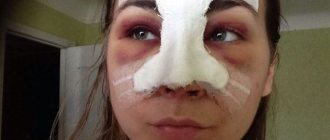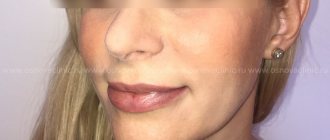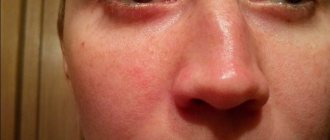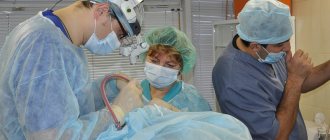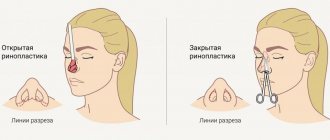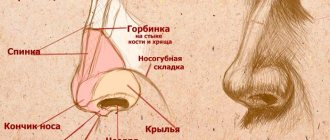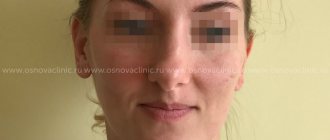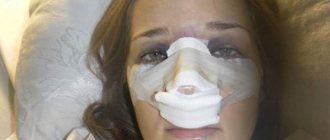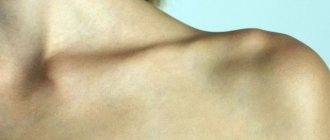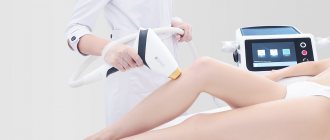Dear doctor, please describe in detail the process of rehabilitation after nose surgery by days, weeks and months.
After rhinoplasty, the patient will have to face some difficulties. Usually the plastic surgeon gives full instructions on how to behave during this period. Don't be afraid to consult a doctor if something is causing you concern. After all, it is better to solve many problems at the very beginning, so that later you can be 100% satisfied with the plastic surgery.
If you are just going to have rhinoplasty, then you should definitely read the article about the features of this operation.
If you have already made the correction, then let's see together what awaits you.
Rehabilitation after rhinoplasty surgery
Recovery after rhinoplasty takes a long time, about six months. The final shape of the nose after surgery can be judged no earlier than the end of this period. During this procedure, the patient must strictly adhere to the surgeon’s recommendations. The final result will largely depend on the quality of care.
The nose after rhinoplasty looks quite scary: it is fixed with a plaster splint, and cotton swabs are inserted into the nasal passages. It is clear that in such conditions patients complain that the nose cannot breathe. However, even after 2-3 days, after the turundas are removed from the nasal passages, breathing will not be completely restored due to swelling. Even after the plaster cast is removed, nasal congestion will still persist for some time, and bruising will be present.
These signs in no way mean that the operation was unsuccessful. The recovery process occurs gradually. Its duration largely depends on the individual characteristics of the patient and quality care. In order to minimize the rehabilitation time, it is necessary to strictly follow all the surgeon’s instructions, which relate to taking medications, local procedures, hygienic and restrictive measures.
Patients and methods
An analysis was made of the course of the postoperative period of 374 patients, 286 women and 88 men, after rhinoplasty (RP) performed at the Art plastic clinic from 2010 to 2014. 218 patients underwent primary surgery and 156 underwent re-correction. The age of the patients ranged from 18 to 58 years (mean age 36±8.62 years).
In the vast majority of cases, 358 (95.7%) patients underwent closed rhinoplasty, 16 (4.3%) patients with columella scar defects after primary surgery underwent open rhinoplasty. In 318 (85%) patients, septoplasty was additionally performed for concomitant curvature of the nasal septum, in some cases in combination with vasotomy of the inferior turbinates. The postoperative period in all patients was without serious complications.
Management of patients after surgery included a number of standard measures that began in the hospital and continued at home. They included visits to the doctor to correct the position of the Denver splint and a number of physiotherapeutic interventions: microcurrent lymphatic drainage, magnetic laser exposure, and phonophoresis with medicinal substances.
Correction of the Denver splint position was carried out every 2-4 days for 10-12 days. At the same time, the splint and adhesive bandage were removed, the skin of the nose was cleaned with an antiseptic lotion, and physical therapy was performed. Then, 30 minutes after physical therapy, the Denver splint was tightly applied again. This tactic helped to restrain the increasing swelling of the soft tissues, as well as to avoid divergence of the nasal bones and other negative aspects that affect the final aesthetic result.
After removing the Denver splint for 2-3 weeks, in order to maintain the new shape of the nose in the context of the beginning scarring process, patients were recommended to fix the external nose with adhesive strips at night for 2 weeks.
Microcurrent lymphatic drainage or exposure to low-power pulsed currents of high frequency (lymphatic drainage mode) was carried out using the Vitality apparatus (Teresa Aesthetic, Russia) starting from 2-4 days after surgery, 3 procedures with a break of 2-4 days, usually on the 3-4th, 5-6th and 8-10th days. The impact was carried out on the area of the eyelids, nose and upper jaw towards the anterior ear lymph nodes (Fig. 1). The choice of this treatment option almost immediately after surgery was due to the fact that during the period of maximum swelling of the soft tissues of the nose, lymphatic drainage helps remove fluid and metabolic products from the intercellular space, as well as improve lymph circulation. In this case, various substances with anti-inflammatory, analgesic, decongestant, hemostatic, regenerating and immunomodulatory effects were used.
Rice. 1. Microcurrent lymphatic drainage of the external nose.
When pronounced hematomas appeared in the periorbital tissue, microcurrent lymphatic drainage was supplemented by exposure to a Milta laser device (Air Comfort, Russia) for 2 minutes on each side with a power of 50 mW at a frequency of 150 Hz, non-contactly at a distance of 2-5 mm from the surface of the face (Fig. 2) . Indications for its use were also the presence of severe irritation from the patch strips. The number of procedures, as a rule, was determined individually and usually amounted to 2-3 sessions. This device was combined and, in addition to laser, allowed for infrared, magnetic and light effects, which significantly expanded the possibilities of physiotherapy after rhinoplasty, allowing to stimulate the growth of new healthy cells, mobilize local immunity, speed up metabolism and have an analgesic effect.
Rice. 2. Impact of a magneto laser on the area of the external nose.
After completing the course of lymphatic drainage and laser therapy, in order to reduce excess scarring, ultraphonophoresis with hydrocortisone or fermenkol (Health Beauty NS-202 device, NEO, China) was performed (Fig. 3), 3-5 procedures 2-3 times a week. In a number of patients with persistent or reappearing subcutaneous lumps, the course of ultraphonophoresis was extended to 3 months, 2-3 times a week.
Rice. 3. Phonophoresis with hydrocortisone ointment.
For various reasons, not all patients were able to complete the proposed postoperative management algorithm, so two groups of patients were formed: the main group (MG) - 286 (86.5%) patients who underwent postoperative rehabilitation according to the developed method, and the comparison group (CG) - 88 (23.5%) of patients for whom it was not performed.
The effectiveness of the proposed algorithm for managing the postoperative period was assessed based on the study of clinical manifestations in the postoperative period, which were assessed initially, after 10-15 days and after 30-35 days. Their severity was determined according to a 6-point system: 0 - the sign is absent, 1 - the sign is barely noticeable, 2 - the sign is weakly expressed, 3 - the sign is moderately expressed, 4 - the sign is strongly expressed, 5 - the sign is very strongly expressed.
The main clinical symptoms were swelling of the soft tissues of the nose, subcutaneous hemorrhages, local subcutaneous induration, swelling of the face and pain in the external nose.
What not to do after surgery
After rhinoplasty, the patient has to radically reconsider his habits. In addition to the fact that you need to choose a sleeping position on your back with the head of the bed raised, it is not recommended:
- Sneezing and blowing nose;
- Excessive facial activity;
- Wearing glasses, since any frame can put pressure on the bridge of the nose;
- Playing sports for at least 2-3 months;
- Lifting weights, as well as habitual movements in the form of bending the body;
- Swimming in the pool and open water;
- Carrying out active cosmetic procedures, peelings, cleansing;
- Tanning and visits to the solarium;
- Consumption of foods that increase tissue swelling.
Wearing clothing that is easy to put on and take off is encouraged. Great attention should also be paid to how to rinse your nose after surgery. There are a lot of pharmaceutical saline solutions for this. The surgeon can provide clear instructions about the nature of the procedure.
Results and discussion
The dynamics of clinical symptoms after surgery are presented in the table.
Dynamics of clinical symptoms in the studied patients Note. *—differences between groups are significant (p<0.05).
Based on the data in the table, there were significant differences between the groups in the parameters of reducing swelling of the soft tissues of the nose and face on days 10-12 and 30-35, as well as reducing subcutaneous hemorrhages and pain in the external nose on days 10-12. which was more pronounced in O.G. Local subcutaneous compactions appeared in both groups after the disappearance of the bulk of the edema on approximately 10-12 days and were more pronounced in the GS ( p
<0.05). The results obtained confirmed the effectiveness of the stage-by-stage implementation of various physiotherapeutic interventions in the postoperative period after rhinoplasty.
Skin of the nose after rhinoplasty
The quality of the skin of the nose after rhinoplasty may noticeably deteriorate, which is associated with the presence of a plaster splint on this area for a week and the lack of hygiene procedures. Most patients note an increase in its fat content, which is sometimes even manifested by the presence of inflammatory or pustular elements. However, surgeons urge you not to rush into carrying out cosmetic procedures for another 10-14 days, and limit yourself exclusively to hygiene using napkins. In the future, you can gradually expand the nature of cleansing procedures and turn to the help of cosmetics that have a mild effect.
Rhinoplasty changes many habits for several months
Rehabilitation after rhinoplasty of the nose involves changing a number of habits:
- You should sleep on your back with the head of the bed raised. This position will limit swelling on the face;
- An important issue in the rehabilitation process is the choice of comfortable clothing with a loose neck that does not require taking it off over the head;
- By learning to move smoothly, you will be able to prevent bleeding and displacement of the sutures. For the same reason, you should stop playing sports for 2-3 months, eliminate heavy lifting and habitual movements in the form of bending the body;
- People leading an active lifestyle will have to give up procedures such as swimming in a pool or swimming in open water for a certain period, since the risk of infections and colds is high. Professional athletes will have to postpone training;
- It will be possible to return to cosmetic procedures, such as cleansing and peeling, no earlier than after 3 months;
- Refusal of tanning and visits to the solarium, since any temperature fluctuations have a bad effect on rehabilitation, and sunbathing contributes to hyperpigmentation of the skin on the nose;
- In terms of nutrition, it is recommended to exclude foods that retain water in the body and support tissue swelling, salted and smoked foods. The diet must be enriched with foods that help prevent constipation;
- You should stop wearing glasses not only because of pain. Any frame, especially a massive one, deforms the bridge of the nose. Until the fabrics have taken their final shape, such exposure should be avoided. Before surgery, it is wiser to switch to contact lenses;
- A decrease in facial activity in the expression of emotions will have a beneficial effect on the course of the recovery process. For the same reasons, the process of sneezing and blowing your nose should be very careful.
As an element of correcting the shortcomings of the operation, beauty injections are relevant. By introducing fillers, it will be possible to compensate for the lack of soft tissue. However, the question of the need for such manipulation and the timing of its implementation is decided by the surgeon. Typically, the procedure is scheduled no earlier than a month after the completion of rhinoplasty.
Useful tips after rhinoplasty
Recommendations from specialists after rhinoplasty also apply to other processes:
- Flights, according to the general opinion of surgeons, can be made no earlier than 7 days after the operation. However, it is better to be able to be under the supervision of a doctor for 2 weeks so that, if necessary, help can be provided immediately;
- Pregnancy should be planned no earlier than one year after rhinoplasty. This delay is associated with hormonal changes during pregnancy, stress during childbirth, as well as the nature of the actions that are necessary to care for the child.
Nasal injections
In some cases, if significant swelling occurs, the attending physician may prescribe injections into the nose. Injections are given with drugs that are intended to relieve the inflammatory process and have a healing effect. The injections are made with microscopic needles, so they are practically painless.
During the rehabilitation period after rhinoplasty, the following drugs are used for injections:
- Diprospan . This drug is the most popular and provides an almost instant effect.
- Glucocorticoid-based products . The administration of this drug increases the level of steroid hormones. The product stimulates carbohydrate and protein metabolism and accelerates tissue healing. The mechanism of action of glucocorticoids is to increase the intensity of blood circulation and increase its volume.
- Injections based on hyaluronidase . This enzyme has the ability to break down hyaluronic acid and helps relieve tissue from excess fluid. The drug has a pronounced anti-inflammatory effect and stimulates the production of collagen fibers.
- Betamethasone disodium phosphate injections . They help get rid of swelling, stimulate the process of hematopoiesis, and stop the formation of postoperative scars. However, this drug has a number of side effects. Such as: increased blood pressure, insomnia and agitation.
When should you worry?
If swelling after rhinoplasty does not go away within the time frame specified by the doctor, this is not always a sufficient reason to start panicking. The fact is that the period of resorption of swelling is individual for each patient. Just following the recommendations is not enough; the rate of tissue healing is largely determined by innate parameters. Thus, some patients have longer recovery times and some have shorter ones.
But there are also situations like this:
- regeneration was noticeably delayed,
- swelling does not lose its severity for a long time,
- the operated area is painful on palpation,
- there is suppuration or heavy bleeding,
- body temperature is very elevated for several days.
These and other situations where unusual sensations, increased discomfort or other uncharacteristic phenomena occur require immediate contact with your doctor.
Drug treatment
If the patient has a slight increase in body temperature, antibacterial treatment may be prescribed. Painkillers are prescribed to relieve pain. If there is a lot of swelling after rhinoplasty, the doctor may prescribe special gels or ointments that help resolve the swelling and bruises at the correction site. For example, “Traumel” or “Badyaga”. You can also rinse your nose with saline solutions based on sea water.
How to remove swelling after rhinoplasty using medication, what ointments to use - all this should be discussed exclusively by a surgeon, since each treatment is individual. Do not use medications without first consulting your surgeon!
